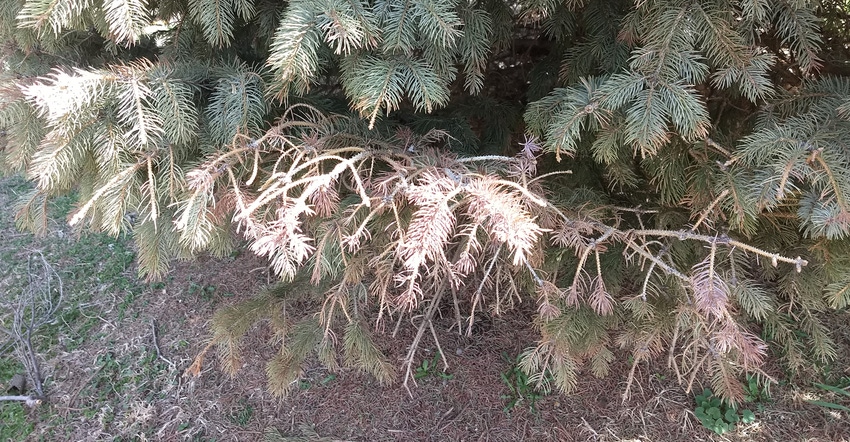
Colorado blue spruce and other spruce varieties are among the most sought-after landscape trees on the farm or in an urban yard or park. As beautiful as these trees are, and as healthy as they normally are, this spring we have seen a greater number of spruce problems across the region. This is a trend.
Spruce issues have been increasing. While they are normally healthy trees, they can be affected by a number of diseases, including Sirococcus shoot blight, Rhizosphaera and Stigmina needle casts, and Cytosopora canker.
According to information gleaned from Nebraska Extension horticulture reports, a combination of stress from drought, weather extremes, incorrect tree care and improper planting techniques have caused a number of dieback issues with spruce trees in the past few years.
Phomopsis dieback
This past winter brought extremely cold weather that could have damaged some trees. But a newer spruce issue that is normally seen more in nursery situations has popped up since 2012 in more and more mature landscape trees among Norway, Engelmann and blue spruce.
Phomopsis dieback causes the dieback of branch tips that appear similar to cold temperature damage, root injury or Diplodia tip blight.
Phomopsis starts in the lower part of the tree and moves up from there. Besides needle death and drop, sometimes resin can be found on the outside of a twig canker. If you cut into and remove the bark from a developing canker, you will notice a brown discoloration.
Sometimes, Phomopsis can progress quite rapidly and cause dieback in a large part of the tree. Cankers can lead to older needle loss that looks similar to needle cast diseases, but leaves the terminal buds still alive. It starts on the younger tissue and will infect the older tissue, which leads to cankers on larger branches.
The best way to deal with this disease is to plant the tree correctly to begin with and take good care of the tree to prevent the possibility of disease. If you notice branch dieback, you can prune out the infected limbs to try to reduce the spread.
Spider mites
Spider mites are another issue to watch in spruce trees, particularly in a dry year. If your spruce trees are turning yellow or brown, you might want to check for spider mites. One way to do this is to take a white sheet of paper and tap or gently shake a branch on top of the paper. If there are spider mites in the tree, hundreds of little specks will fall onto the paper, and they will start to move.
A good hard rain will often take care of spider mites in spruce trees, but you can also control them with horticultural oil, insecticidal soap or systemic insect killers. It is best to contact your local Extension office, local forester or professional arborist for more information.
Spruce are among the most planted evergreen trees in many regions, but it does take a watchful eye and regular tree care to keep them healthy and growing around the farm and ranch.
About the Author(s)
You May Also Like






